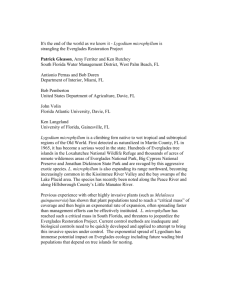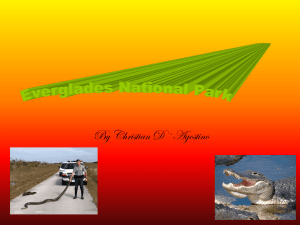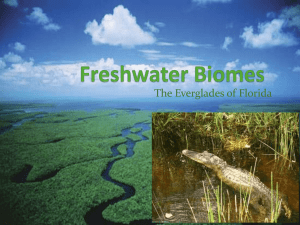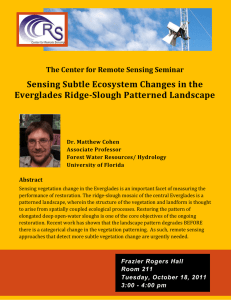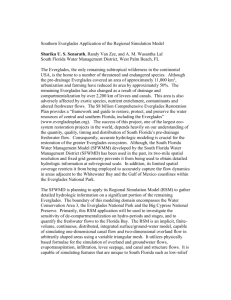2025 Vision for the Everglades
advertisement
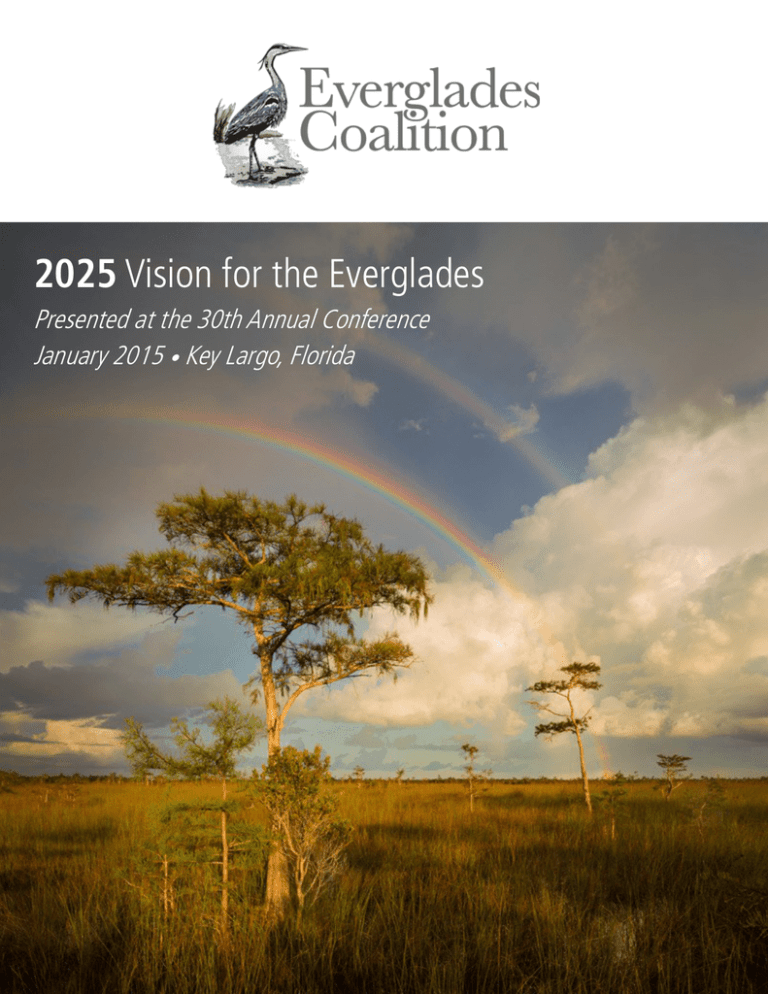
2025 Vision for the Everglades Presented at the 30th Annual Conference January 2015 • Key Largo, Florida Vision for America’s Everglades In 2000, the U.S. Congress passed the landmark Comprehensive Everglades Restoration Plan (CERP). The largest ecosystem restoration plan ever undertaken, CERP was championed as a landmark accomplishment for America’s Everglades. The plan was envisioned to take decades to construct with sustained levels of leadership and funding from our federal and state governments. Fifteen years later, as the Everglades Coalition prepares to celebrate its 30th annual conference, much has changed in the landscape of restoration. Progress has been made, and new challenges have emerged. Our vision for the Everglades over the next decades includes a combination of historic goals (water quality improvement, restored sheetflow) and new ones (offsetting climate change impacts and protection against oil drilling). The Everglades Coalition’s vision for America’s Everglades for 2025 includes eight specific goals which capture those objectives we feel are most critical to successful longterm restoration of the iconic “River of Grass.” Vision 1 // Growth Management & Land Acquisition Lands necessary for restoration are brought under perpetual conservation status to expand the spatial extent of wetlands and associated uplands and prevent inappropriately-sited development that undermines restoration. Vision 2 // Wildlife, Plant & Ecosystem Biodiversity A network of protected land and water is conserved and managed for viable and abundant populations of native plants and animals. Vision 3 // Water Quality Abundant clean freshwater exists for the Greater Everglades and its estuaries. Vision 4 // Water Storage America’s Everglades and estuaries thrive with sufficient flows of clean water that come from adequate storage throughout the system, including the Everglades Agricultural Area and the Kissimmee Valley. Vision 5 // Climate Resiliency Everglades restoration is the central component of climate adaptation and resiliency planning and implementation. Vision 6 // Energy Policy Florida’s energy choices do not compromise land and water resources critical to Everglades restoration efforts. Vision 7 // Sustainable Regions Ecosystem-wide benefits are achieved to support connectivity across a unique and diverse landscape, and stem ecological decline. Vision 8 // Federal & State Leadership Restoration sees substantial progress with full partnership and commitment at the highest levels of the federal and state governments. Vision 1 // Growth Management & Land Acquisition Lands necessary for restoration are brought under perpetual conservation status to expand the spatial extent of wetlands and associated uplands and prevent inappropriately-sited development that undermines restoration. Urban sprawl has had, and continues to have, significantly harmful impacts on the Everglades, its world-renowned wildlife diversity, natural resources, and our quality of life. Sprawl has reduced the size of the Everglades to about half its original size and led to secondary degradation of the remaining wetlands, their associated uplands and the overall functioning of the natural system as a result of habitat degradation, pollution, drainage and water demands and infrastructure impacts. To be sustainable in the 21st century, Florida must adopt a modern economic model that reflects the negative costs of development on all of these elements, and the positive economic, utilitarian and social values of natural resources on which our state’s economy is based. We must protect the remaining wetlands, uplands and the other undeveloped acreages for their current or restoration values and maintain sustainable agricultural land as a buffer between urban and natural areas. As we engage in the largest ecosystem restoration project in the world, we must immediately cease the loss and fragmentation of lands and waters in the greater Everglades and enlarge and restore the existing spatial extent of the ecosystem through hydrological and wildlife habitat restoration. ROADMAP TO ACCOMPLISH THE VISION Ensure Effective Growth Management Reinstate appropriate statewide growth management oversight to protect Florida’s resources and plan for its future. Strengthen county planning restrictions to prevent new development on natural areas that are important to current planned or future restoration efforts and to the long–term survival of the Everglades and coastal estuary communities. Prioritize infill and redevelopment to sustainably strengthen our urban communities, relying on improving and expanding public mass transportation options while restricting construction of new or expanded roadways and thoroughfares. Maintain urban development boundaries; prevent further encroachment into agricultural, natural areas and open space; avoid the introduction of new major industrial, commercial, residential, mining developments. Require new developments to retain on-site native vegetation and habitat connections to other areas for native wildlife. Where clearing is unavoidable for appropriate growth, require the use of native plants in all landscaping and mitigation. Avoid setting up human-wildlife conflict by preserving areas where panthers, bears and other native wildlife habitat exist. Require new development projects to pay for their own infrastructure requirements instead of adding to taxpayer burden. Maintain water concurrency by requiring proof of adequate supply prior to approval of new development applications. Deny permits and restrict land uses in areas that are projected to be at risk from sea level rise and associated impacts. Make all permitting decisions a transparent, public process. Utilize land valuations that calculate the value of ecosystem services. Encourage the creation of a state Resource Planning and Management Committee to comprehensively address issues related to lands important to restoration, including in the Everglades Agricultural Area and other sensitive lands. Utilize the Farm Bill and other sources intended for land acquisition to help achieve Everglades restoration. Wetlands and Other Natural Areas Protection Prohibit any net loss of wetlands, associated uplands, Florida native plant communities, and wildlife habitat. Maintain existing wetlands within their natural communities and accelerate restoration to keep water tables high, recharge the reservoir, prevent salt water intrusion, and lessen the effects of sea level rise. Identify areas of environmental concern in each region and ensure that government agencies are able to weigh in on local development projects that propose to impact these critical lands and associated restoration projects. Support the state land acquisition program, Florida Forever, with funding levels that meet critical needs of the greater ecosystem such as land purchases that enhance water treatment and restored flows south to Everglades Nation Park. Enforce legal requirements of avoidance of wetland impacts and assess historic wetland losses. Increase upland protection as an integral part of the ecosystem. Vision 2 // Wildlife, Plant & Ecosystem Biodiversity A network of protected land and water is conserved and managed for viable and abundant populations of native plants and animals. Ultimately, success of Everglades restoration will be measured through the recovery of native wildlife. South Florida’s diverse ecological communities, unique in the world, a focal landscape for biological diversity, rare and endangered species¹, must be restored and managed as a whole to support all animals and plants and the interdependent wetland, upland and marine habitats native to the region. South Florida’s wildlife need sufficient contiguous habitat to sustain them in the face of climate change, as well as the continuing habitat loss, degradation and fragmentation from development, roads, invasives, and inadequate land and water management. The resilience of healthy natural communities with their full array of native species and interdependent functions yields benefits for all – wildlife, the Everglades, and people. ROADMAP TO ACCOMPLISH THE VISION Protect Intact Large Swathes of Habitat Control growth, mining and development that threaten habitat necessary for species at risk. Acquire title and conservation easements for priority wildlife areas and habitat links. Protect and restore a greater percentage of habitat quality and connectivity on private lands. Prevent road projects that further fragment habitat; maintain habitat and hydrological connectivity and safe passage for wildlife and people by developing a comprehensive transportation and wildlife crossings plan. Fund and Support Conservation and Restoration Efforts Fully fund Florida Forever and revitalize the state’s environmental land protection programs. Ensure sound implementation of the Florida Water and Land Legacy constitutional amendment. Provide necessary funding to responsibly manage public conservation lands and restore wildlife habitat, both wetlands and uplands, on federal, state and local ands with effective programs to control invasive plant and animal species. Promote wildlife-compatible agricultural practices. Use less-than-fee acquisition and incentive programs to prevent loss of wildlife-compatible agricultural lands. Establish land acquisition programs in all Florida counties. Appoint individuals to agency and board positions, including the Fish and Wildlife Conservation Commission and Water Management Districts, who are committed to the protection and recovery of state and federally listed wildlife species. Stop abuses of the Right to Farm Act that circumvent local land use restrictions and avoid state and federal permitting obligations set in place to protect wildlife and habitat. Control Invasive Species Establish, fund, and support federal and state programs that prevent the importation and spread of exotic nuisance species. Employ eradication and management programs at the state and federal level to stop the expansion of invasive species range and prevent invasives from outcompeting native flora and fauna for food and habitat throughout the system. Provide Floridians and visitors with educational materials on the impacts of invasives, management, and proper disposal. Encourage Fact-Based Approaches to State Listing of Species Assure the state listing process for at-risk species utilizes scientifically-based criteria that meet international and federal standards to protect best Florida’s wildlife populations before entering the dangerously low levels of endangered status. ¹ As of November 2014, South Florida has over 70 animals and 30 plants on the federal endangered species list and additional species at risk listed by the state. Vision 3 // Water Quality Abundant clean freshwater exists for the Greater Everglades and its estuaries. From its headwaters to its estuaries and bays, the health of the Greater Everglades depends on sufficient flows of clean freshwater to restore the River of Grass. Water quality improvements are needed to ensure the success of the Comprehensive Everglades Restoration Plan (CERP) and other restoration projects that are being constructed or are planned. Stopping nitrogen and phosphorus pollution at its source reduces clean-up costs and prevents additional water quality degradation; source control should be prioritized over costly stormwater treatment systems. Water quality treatment must be substantially expanded to handle agricultural and suburban/urban runoff. ROADMAP TO ACCOMPLISH THE VISION Acquire additional lands in the Greater Everglades needed to improve water quality and flow. Complete Restoration Strategies project; implement the science plan to maximize phosphorus reduction. Allow local governments to establish more stringent regulations to protect water quality within their boundaries. Refine Best Management Practices (BMPs) in the Greater Everglades region according to phosphorus and nitrogen reduction effectiveness; strengthen and enforce mandatory BMPs. Meet the minimum sampling thresholds in the Impaired Water Rule. Optimize the performance of Stormwater Treatment Areas (STAs) to meet or exceed design performance. Set numeric water quality standards, including downstream protective values, for nitrogen and phosphorus to protect the historic natural balance of flora and fauna found throughout the Greater Everglades ecosystem. Protect natural wetlands. Prohibit their use and/or conversion into stormwater treatment areas; when natural wetlands are destroyed, ensure “mitigation” requires like-for-like replacement in an appropriate location that benefits restoration. Establish and enforce urban stormwater standards to ensure that new development, when approved based on appropriate statewide growth management criteria and sustainability ethic, neither causes nor contributes to downstream impairment. Reject changes in the definitions of water quality standards to maintain and prevent reduction in the protection provided by the “swimmable/fishable” standard goals set out by the Clean Water Act and applied to designated waterbodies in Florida. Establish and implement Total Maximum Daily Loads (TMDL) and Basin Management Action Plans (BMAP) within five years of a determination that a waterbody is impaired to ensure further degradation is prevented to the greatest extent possible. Establish flow rates sufficient to prevent polluting nutrient and salinity concentrations to meet the needs of flora and fauna. Monitor stormwater management systems to maintain and improve effectiveness; require expansion and upgrades of ineffective stormwater management systems until facilities produce water quality that complies with protective standards. Prevent pollution from the use of reclaimed/reuse wastewater. Vision 4 // Water Storage America’s Everglades and estuaries thrive with sufficient flows of clean water that come from adequate storage throughout the system, including the Everglades Agricultural Area and the Kissimmee Valley. During the past century of drainage of the Everglades, more than half of South Florida’s wetlands and nearly all of its uplands have been lost, and the Central & Southern Florida Project has inflicted immense damage on the remaining natural areas. Restoration and rehabilitation of the Everglades, its estuaries, and Lake Okeechobee will require that the natural function of these lost drained areas be recovered or reproduced. Among the most important functions to recover are water storage, treatment, and sheetflow consistent with the region’s seasonal rains. Historically, the vastness and interconnectedness of the Everglades provided these services; they must be restored as quickly as possible if Lake Okeechobee, the estuaries, and the Everglades and Florida’s economy are to survive. ROADMAP TO ACCOMPLISH THE VISION Uphold water as a public resource. Oppose efforts to redefine it as a private commodity or property right. Require that water supply planning processes to include water supply needs for the natural system. Make the funding of Everglades restoration the highest priority because of its critical role in supporting Florida’s economy, public health, and quality of life; ensure that appropriators across the aisle support this critical mission. Prioritize land acquisition based on the urgent need to store and treat water required to restore the Everglades, alleviate the struggling estuary communities, and protect Florida’s water supplies for environment, agriculture and urban communities. Dedicate funds to acquire 46,800 acres of land in the EAA by May 2015 by the option expiration in October 2015. Purchase the remaining EAA lands not acquired by October 2015 before the last contractual option expires in 2020. Capitalize on the immense opportunity represented by the acquisition of land and immediately commence a Comprehensive Everglades Restoration Plan (CERP) planning and funding process for using the acquired parcels. Authorize and construct the Central Everglades Planning Project (CEPP) to send water south through the heart of the ecosystem, relieving coastal estuaries of damaging flows while redirecting freshwater to Everglades National Park and Florida Bay. Protect water for CERP projects and natural systems of the Greater Everglades through the establishment and operation of water reservations, restricted area allocation rules, water conservation policies, and other legal tools to ensure the availability of water to restore and support fish and wildlife. Vision 5 // Climate Resiliency Everglades restoration is the central component of climate adaptation and resiliency planning and implementation. Florida’s geology is made of porous lime rock, therefore as sea level rises it will not only present problems along the coast but in low-lying areas in the interior. Returning freshwater flow at an accelerated rate into the southern end of the system is a vital component to building resiliency against sea level rise. Restoring fresh water flows will prevent land loss from sea level rise impacts by building up peat, prevent further subsidence and maintain freshwater marshes, protect our water supply by creating a freshwater head and preventing further saltwater intrusion, maintain and protect water quality in coastal estuarine communities, and prevent the loss and fragmentation of habitat. ROADMAP TO ACCOMPLISH THE VISION Promote Everglades restoration projects as central to resiliency efforts. Incorporate Everglades restoration into climate change adaptation and resiliency planning at the local, state, and national levels. Accelerate and maximize benefits of Everglades restoration projects to optimize resiliency to sea level rise and storm surge. Illustrate the effectiveness of accelerating restoration as a solution to help people visually realize the effectiveness of pushing back on saltwater intrusion with freshwater inundation. Ensure low lying areas are protected from new development. Ensure all new development plans identify CERP footprints and adjacent low-lying areas that may also need protection. Increase partnerships with the business community to make the economic connections between Everglades restoration and sea level rise resilience for elected officials and the public. Include climate benefits in Everglades restoration plans cost benefit analysis. Incorporate climate adaptation and resiliency for Everglades restoration in all regional planning. All new planning considers cumulative implications of every project and how it may affect the results of Everglades restoration. Prioritize and accelerate efforts to implement Everglades restoration plans and projects that increase resilience to sea level rise. Ensure that energy policies contain a natural resources section intended to provide dedicated funding to help wildlife and the habitats they rely on to cope with the adverse impacts of climate change. Such provisions will include directing funding to the restoration of aquatic ecosystems, including the Everglades. Create a large-scale, well-connected, sustainable system of protected natural habitat areas across the region. Manage land for restoring and enhancing ecosystem function and resiliency to conserve biological diversity. Prioritize research needs and pursue collaborative partnerships with the academic and research communities to ensure that the best available science is informing management actions. Minimize structural compromises to the already fragile karst geology. Re-evaluate existing policies and programs to incorporate climate change and seek regulatory changes as appropriate. Vision 6 // Energy Policy Florida’s energy choices do not compromise land and water resources critical to Everglades restoration efforts. Energy generation and consumption can take an enormous toll on Florida’s natural resources, fish and wildlife habitat, and water supply critical to restoring water flow through the greater Everglades ecosystem. Nuclear, coal and natural gas-fired power plants are among the most water-intensive electricity sources and pose a myriad of environmental risks, including carbon pollution, excavation and filling of wetlands, and degraded water quality. The consumption of electricity is responsible for 42% of greenhouse gas emissions in Florida, which exacerbate climate change impacts including sea level rise. The extraction of oil and natural gas present risks of contamination of water resources, intensive consumptive water use and hazardous waste disposal concerns. Recognizing that full implementation of Everglades Restoration is crucial to combating saltwater intrusion and mitigating sea level rise, Florida should focus on conservation, efficiency, and renewable energy sources. Infrastructure dependent nonrenewable energy sources is in conflict with Everglades restoration priorities and is harmful to people and wildlife. ROADMAP TO ACCOMPLISH THE VISION Implement a renewable portfolio standard (RPS) approved by the Florida Legislature achieving 20% renewable energy generation with a standard that includes only truly renewable energy resources, excluding nuclear or coal-derived energy. Support the EPA Clean Power Plan’s carbon pollution reduction targets for Florida and the flexible compliance mechanisms within the plan that include increased energy efficiency implementation and meaningful renewable energy development. Adopt federal and state legislation implementing an 80% reduction of greenhouse gas emissions below 1990 levels by the year 2050; Florida municipal and county governments strive to meet this same goal under a unified state vision. Maintain current Florida net metering policy that promotes distributed solar power generation. Remove regulatory and tax burdens from third-party solar ownership models in Florida. Support meaningful energy conservation goals for the state’s biggest utilities. Prevent the expansion of those energy production uses that are incompatible with the health of the greater Everglades ecosystem, such as sugarcane ethanol, coal plants, nuclear plants and oil and natural gas extraction. Enact a statewide ban and re-enact a federal moratorium prohibiting near-shore oil drilling off Florida’s coastline. Guarantee adequate water supply for restoration from all available sources prior to authorizing withdrawals for energy facilities. Pass legislation regulating enhanced extraction activities in Florida that will effectively protect water supply and the environment. Minimize environmental risks through containment and disposal of wastes from energy facilities, including hazardous wastes. Vision 7 // Sustainable Regions Ecosystem-wide benefits are achieved to support connectivity across a unique and diverse landscape, and stem ecological decline. Everglades restoration will have important and significant economic benefits, including water supply protections for nearly 8 million Floridians. Biodiversity of plant and animal species throughout the Greater Everglades Ecosystem must be restored. Hydrologic connectivity, interdependent and stepping stone habitats are all necessary to achieve comprehensive restoration. Key benchmarks of success include: Sufficient clean water will be available for the Everglades and estuaries. By 2030, the ecological decline of Lake Okeechobee will be measurably reversed. Sheet flow to the Southern Everglades and Everglades National Park is restored with identifiable wildlife recovery benefits all the way to Biscayne and Florida Bays. Harmful discharges to the St. Lucie and Caloosahatchee Rivers and estuaries will be significantly reduced. The Caloosahatchee estuary receives the water needed to maintain a healthy salinity balance in the dry season. Water and wildlife habitat connectivity is maintained and recreated to benefit a large number of species including the Florida panther, Everglade snail kite and Cape Sable seaside sparrow. ROADMAP TO ACCOMPLISH THE VISION Northern Everglades & Coastal Communities Complete and fully implement protection plans for the Northern Everglades and Estuaries Protection. Reduce significantly nutrient loading to Lake Okeechobee to improve conditions in the lake and estuaries. Fully fund Florida Forever or its successor program to meet the land acquisition needs for water storage and treatment within the Caloosahatchee and St. Lucie Estuary watersheds. Develop additional natural and other water storage options to sufficiently reduce harmful estuary discharges. Authorize, fund, and construct the Central Everglades Planning Project (CEPP) to send water south. Complete Kissimmee River Restoration, Picayune Strand Restoration Project, C-44 Reservoir and STA, and C-43 Caloosahatchee Basin Reservoir projects; ensure that all of these projects are operated to maximize ecological benefits. Address seepage loss from Central Everglades by completion of the Broward Water Preserve C-111 Impoundment project. Central & Southern Everglades Complete C-111 South Dade, C-111 Spreader Canal, Biscayne Bay Coastal Wetlands Project, 6.5 miles of Tamiami Trail bridging, and CEPP. All of these projects are operated to significantly increase freshwater flows to Everglades National Park, Florida Bay, Biscayne Bay, and Northeast Shark River Slough and Taylor Slough. Improve sheetflow through the Everglades by decompartmentalizing the water conservation areas and operating a completed Modified Water Deliveries Project with an L-29 stage of 8.5 feet in conjunction with C-111 South Dade and C-111 Spreader Canal projects. The provisions for acquiring land in the Everglades National Park Protection and Expansion Act of 1989 are fulfilled, and no private land ownership within Everglades National Park interferes with restoration of natural water flow. Acquire River of Grass lands and streamline project development to accelerate needed storage capacity and treatment in the Everglades Agricultural area; project development includes ample stakeholder input. Restore ridge and slough landscape pattern. Vision 8 // Federal & State Leadership Everglades restoration sees substantial progress with full partnership and commitment at the highest levels of the federal and state governments. Everglades restoration remains a high priority across the nation and in Florida with strong champions and visible successes in sending clean water south. Science-driven restoration is accelerated to avoid unreasonable and undesirable results with full bipartisan commitment from the highest levels of the federal and state governments. ROADMAP TO ACCOMPLISH THE VISION Leadership Garner strong bi-partisan support from elected officials in U.S. Congress, the Florida Legislature, county and municipal governments who recognize the important economic and biological benefits of facilitating Everglades restoration. Appropriate an average of $400M annually from the state and federal governments as envisioned by CERP in 2000. Resume passage of the Water Resources Development Acts (WRDA) on a bi-annual schedule to provide timely Congressional authorization for a suite of Everglades restoration projects; provide regular funding intervals for newly-authorized projects. Appoint demonstrated Everglades champions to high-level state and federal leadership roles, including U.S. Department of Interior, U.S. Army Corps of Engineers, Governing Board of the South Florida Water Management District, the Florida Department of Environmental Protection, as well as key decision-making committees in Congress and state legislature. Expand the Congressional Everglades Caucus, with particular focus on non-Florida membership and work to ensure the Caucus’ effectiveness in helping to foster new champions for Everglades restoration nationwide. Ensure that federal and state laws are consistent with the goals of Everglades restoration, including but not limited to the Clean Water Act and National Environmental Policy Act. Progress on CERP and Other Restoration Projects Authorization and full funding are achieved for Kissimmee River restoration, C-111 South Dade Project, Modified Water Deliveries, 6.5 miles of Tamiami Trail bridging, C-44 St. Lucie Reservoir, C-43 Caloosahatchee Reservoir, Biscayne Bay Coastal Wetlands Project Phase 1, Picayune Strand, Broward Water Preserve Areas C-11 Impoundment and Central Everglades Planning Project; these projects are operated for maximum ecological benefits. Promote operational standards for the best Everglades ecological outcomes with adequate monitoring to ensure consistency with restoration goals. Completed projects, including C-111 Spreader Canal Phase 1, Modified Water Deliveries and Tamiami Trail are operated comprehensively to maximize benefits to the restoration of wildlife and habitat. Streamline project planning and land acquisition to expeditiously build necessary storage and treatment in the Everglades Agricultural Area to send clean water south to Everglades National Park and Florida Bay, and away from coastal estuaries. Prioritize and accelerate CERP and other restoration projects based on the greatest ecological benefits. This benefits determination is made utilizing sound science, incorporating emerging science and the urgency for completing Everglades restoration projects as adaptation to climate change. Ensure that science remains the driving force for decisions in support in CERP project implementation and policy. About the Everglades Coalition The Everglades Coalition is an alliance of 56 local, state, and national conservation organizations dedicated to full restoration of America’s Everglades — from the Kissimmee Chain of Lakes into Lake Okeechobee, through the "River of Grass," out to Florida and Biscayne Bays and the Keys. Everglades Coalition Member Organizations: 1000 Friends of Florida Arthur R. Marshall Foundation Audubon Florida Audubon Society of the Everglades Audubon of Southwest Florida Caloosahatchee River Citizens Association / Riverwatch Center for Biological Diversity Clean Water Action Collier County Audubon Society Conservancy of Southwest Florida Defenders of Wildlife Ding Darling Wildlife Society Earthjustice Environment Florida Everglades Coordinating Council Everglades Foundation Everglades Law Center Florida Conservation Alliance Florida Defenders of the Environment Florida Keys Environmental Fund Florida Native Plant Society Florida Oceanographic Society Florida Wildlife Federation Friends of the Arthur R. Marshall Loxahatchee National Wildlife Refuge Friends of the Everglades Hendry Glades Audubon Society Institute for Regional Conservation Izaak Walton League Florida Division Izaak Walton League Florida Keys Chapter Izaak Walton League Mangrove Chapter Izaak Walton League of America Last Stand League of Women Voters of Florida Loxahatchee River Coalition Martin County Conservation Alliance National Audubon Society National Parks Conservation Association National Wildlife Federation National Wildlife Refuge Association Natural Resources Defense Council Ocean Research & Conservation Association Reef Relief Sanibel-Captiva Conservation Foundation Save It Now, Glades! Sierra Club Sierra Club Broward Group Sierra Club Calusa Group Sierra Club Central Florida Group Sierra Club Florida Chapter Sierra Club Loxahatchee Group Sierra Club Miami Group Snook and Gamefish Foundation South Florida Audubon Society Southern Alliance for Clean Energy Tropical Audubon Society Urban Environment League of Greater Miami Learn more by visiting us at evergladescoalition.org All photos in this publication generously shared by Paul Marcellini View and purchase Paul’s work online at paulmarcellini.com This document was printed on recycled paper certified by the Forest Stewardship Council

